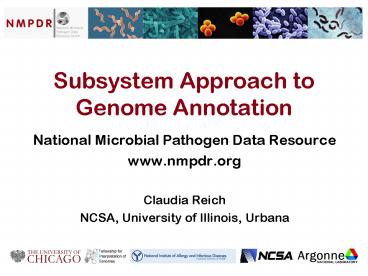Subsystem Approach to Genome Annotation - PowerPoint PPT Presentation
1 / 20
Title:
Subsystem Approach to Genome Annotation
Description:
Subsystem Approach to Genome Annotation National Microbial Pathogen Data Resource www.nmpdr.org Claudia Reich NCSA, University of Illinois, Urbana – PowerPoint PPT presentation
Number of Views:117
Avg rating:3.0/5.0
Title: Subsystem Approach to Genome Annotation
1
Subsystem Approach to Genome Annotation
- National Microbial Pathogen Data Resource
- www.nmpdr.org
- Claudia Reich
- NCSA, University of Illinois, Urbana
2
Complete Microbial Genomes
- 464 complete microbial genomes in NCBI as of
3-1-07 - 691 microbial genomes in progress as of 3-1-07
3
Making Sense of Genome Data
- Locate Genes identify ORFs automatically
- GeneMark
- NCBIs ORF Finder
- Glimmer
- Critica
- Assign Function by sequence similarity to
experimentally characterized proteins - BLAST family of sequence comparison tools
4
Problems with Assignments by Similarity
- When ORF is a member of a protein family
- Paralogous genes
- ORFs encoding similar proteins acting on
different substrates - Assignments can be transitive, and many times
removed from experimental data
5
Other Factors Can Aid in Function Assignments
- Molecular phylogeny
- Paralogous and orthologous families
- Conserved gene neighborhood
- Metabolic context
- Bidirectional best hit matches across multiple
genomes
6
Incorporating Information Other Than Similarity
- KEGG manually curated pathway and metabolic maps
- GO vocabularies that describe ORFs as associated
with - biological processes
- cellular components
- molecular function
- MetaCyc experimentally elucidated metabolic
pathways
7
What is Needed
- A system that
- integrates all the above concepts
- organizes genomic data in structured idioms
- allows high-throughput annotation of newly
sequenced genomes - resolves discrepancies in different annotation
tools - informs experimental research
8
Enter the SEED
- Database and annotation environment
- Underlies, and accessible through, NMPDR
(www.nmpdr.org) - Expert annotation via subsystems building
- Provides the most accurate genome annotations
available - Argonne National Lab, University of Chicago,
UIUC, FIG
9
What is a Subsystem?
- Any organizing biological principle
- metabolic pathway
- amino acid biosynthesis, nitrogen fixation,
glycolysis - complex structure
- ribosome, flagellum
- set of defining features
- virulome, pathogenicity islands
- functional concept
- bacterial sigma factors, DNA binding proteins
10
Subsystems are
- Sets of functional roles, which are functions, or
abstractions of functions (such as an EC number),
that together implement a specific biological
process or concept - Created manually by expert curators
- Experts annotate single subsystems over the
complete collection of genomes, thus contributing
and sharing their expertise with the scientific
community
11
How Subsystems are Built
- Create a subsystem for the biological concept,
and define the functional roles - In one (or a few) key organisms that include the
subsystem, find the genes and assign meaningful
functional names - Project the annotations to orthologous genes
- Expand to more genomes, creating a Populated
Subsystem
12
Populated Subsystems
- Are Spreadsheets where
- Columns functional roles
- Rows specific genomes
- Cells genes in the organism that implement the
functional role
13
How to Access Subsystems
- From Home page (left navigation bar) Subsystem
Summaries select organism - From Organism pages
- From Subsystem Search
- From protein pages to specific subsystems
14
Subsystem Pages in NMPDR
- Table of Functional Roles
- Subsystem diagram (if appropriate)
- Populated subsystem spreadsheet
- Customizable spreadsheet viewing options
- Functional variants and subsets of roles
- Curators notes
15
Benefits of Subsystems
- More accurate annotations
- Annotation of protein families
- Analysis of sets of functionally related proteins
- Less error-prone to automatic projections to
novel genomes
16
Subsystems Reveal Interesting
- Pathway variants
- Are they clustered by phylogeny?
- Delta subunit of RNA polymerase only Bacillales
- Are they clustered by functional niche?
- Horizontal gene transfer?
- Fused genes
- ? and ? subunit of RNA polymerase fused in
Helicobacter - Fissioned genes
- ? subunit of RNA polymerase is fissioned in
Cyanobacteria
17
Subsystems Reveal Interesting
- Duplicate assignments
- More than one gene for one functional role?
- Alpha subunit of RNA polymerase in Magnetococcus
and Francisella - Same sequenced region in more than one contig in
partially assembled genomes? - Frameshifts or other sequencing errors?
- Annotation errors?
18
Subsystems Reveal Interesting
- Missing genes
- Is the function essential?
- Is the function conserved?
- Does the missing gene cluster with homologs in
other organisms? - Is the function performed by a newly recruited
gene? - Has a gene been acquired by horizontal gene
transfer and now performs that function?
19
Synthesis of Selenocysteinyl-tRNA
- Two known pathway variants
- One step in Bacteria
- SelA is annotated
- Two steps in Archaea and Eucarya
- PSTK was missing until very recently
20
Explore Selenocysteine Usage
- Start by searching for gene name, selA, in an
organism known to use Sec, E. coli K12 - Start from subsystem tree expand category of
"Protein metabolism," expand subcategory of
"Selenoproteins" - Open "Selenocysteine metabolism" subsystem from
protein page or SS tree - Genomes arranged phylogenetically
- Roles defined on mouse-over
- What genes are missing in which organisms?
- Are there Sec metabolism genes present in any
organisms that do not have proteins that need
Sec? - Are there organisms known to need Sec for certain
proteins, but that do not have a complete Sec
biosynthesis pathway? - Why is there a hypothetical protein included in
this subsystem?































